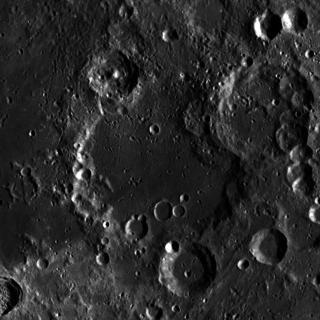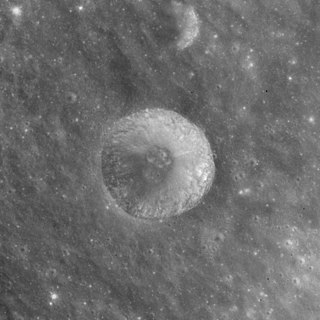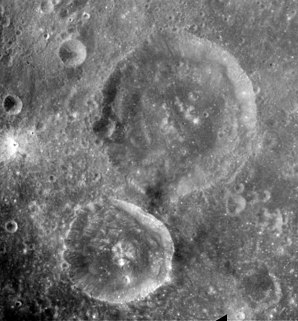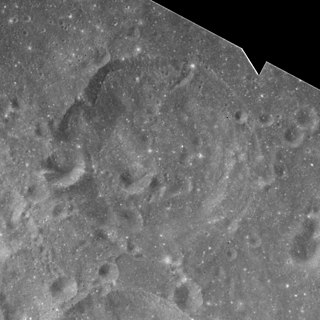
Langrenus is an impact crater located near the eastern lunar limb. The feature is circular in shape, but appears oblong due to foreshortening. It lies on the eastern shore of the Mare Fecunditatis. To the south is the overlapping crater pair Vendelinus and the smaller Lamé.

Vendelinus is an ancient lunar impact crater located on the eastern edge of Mare Fecunditatis. To the north of Vendelinus is the prominent crater Langrenus, while to the southeast is Petavius, forming a chain of prominent craters near the eastern rim. Due to its location, the crater appears oblong due to foreshortening.

Al-Marrakushi is a small, relatively isolated lunar impact crater in the eastern Mare Fecunditatis. It is a circular, symmetrical formation, with inner walls that slope down to the midpoint. To the northeast is the prominent crater Langrenus. The mare near Al-Marrakushi is marked by ray material from its larger neighbor.

Acosta is a small lunar impact crater located just to the north of the prominent crater Langrenus, near the east edge of Mare Fecunditatis. To the west are the trio of Atwood, Naonobu, and Bilharz. Acosta is named after the Portuguese naturalist Cristóvão da Costa.

Lohse is a lunar impact crater on the eastern edge of Mare Fecunditatis. It is attached to the north rim of the larger crater Vendelinus. To the north is the prominent Langrenus. The interior of Lohse is rough, being partially covered by ejecta from Langrenus. It has a small central peak. An older impact is attached to the north rim, designated Langrenus E.

Born is a small lunar impact crater located near the eastern edge of the Moon, to the northeast of the prominent crater Langrenus. It was previously designated Maclaurin Y before being named by the IAU in 1979. Maclaurin itself lies to the north.

Atwood is a small earth moon impact crater that is located on the Mare Fecunditatis, to the northwest of the prominent crater Langrenus. It forms a triple-crater formation with Naonobu attached to the north rim and Bilharz near the west rim.

Back is a small lunar impact crater that is located near the eastern limb of the Moon. It lies on the northwest edge of the Mare Smythii, and the northeast rim is adjacent to the crater Schubert. To the west is Jenkins, and to the southwest is the Weierstrass–Van Vleck crater pair.

Naonobu is a small lunar impact crater named after Japanese mathematician Ajima Naonobu. It is located on the eastern Mare Fecunditatis, to the northwest of the prominent crater Langrenus, and it forms a triple-crater formation with the adjacent Atwood to the south and Bilharz just to the southwest. Naonobu and Atwood are separated by only a few kilometres.

Beals is a lunar impact crater that is located near the eastern limb of the Moon, and lies across the southwestern rim of the crater Riemann. From the Earth the crater is viewed nearly from on edge, and is best seen during favorable librations. To the west is the large walled plain Gauss.

Becquerel is a lunar impact crater that lies in the northern hemisphere on the far side of the Moon. This is an ancient and heavily worn formation that is now little more than an irregular buri in the surface. The outer rim has been worn and reshaped until it forms a rugged, mountainous region around the flatter interior.

Barkla is a lunar impact crater that lies near the eastern limb of the Moon. It is located to the east of the prominent crater Langrenus, and was formerly designated Langrenus A before being renamed by the IAU in 1979. Due east of Barkla is Kapteyn, a formation only slightly larger with a similar size. Southwest of Barkla is the crater Lamé.

Dollond is a small lunar impact crater that is located in the central region of the Moon, to the north of the crater Abulfeda. It was named after British optician John Dollond. Due west of Dollond is Anděl. Dollond is circular and cone shaped, with a tiny floor at the midpoint of the sloping interior walls.

Eckert is a tiny, isolated lunar impact crater in the northern part of the Mare Crisium. This crater forms a circular pit in the dark surface of the surrounding lunar mare. Just to the west is a wrinkle ridge in the mare surface, a feature that is prominent only under oblique lighting from the Sun. The nearest craters of note are Peirce to the west-northwest, and Picard to the southwest. Both of these craters lie in the Mare Crisium basin.

Somerville is a small lunar impact crater in the eastern part of the Moon. It lies to the east of the prominent crater Langrenus, and was designated Langrenus J before being given a name by the IAU. This is a roughly circular, bowl-shaped formation, with the larger but less conspicuous Langrenus H attached to the northwest rim. The rim has a protruding lip that extends slightly toward the southwest.

Bondarenko is a lunar impact crater on the far side of the Moon. It is located to the northeast of the large, dark-floored crater Tsiolkovskiy, and south of the crater Chauvenet. This is a worn crater formation with an irregular floor, similar to other craters in the area, which are covered by ejecta from Tsiolkovskiy.

Mons Hadley is a massif in the northern portion of the Montes Apenninus, a range in the northern hemisphere of the Moon. It has a height of 4.2 km (14,000 ft) above the adjacent plain and a maximum diameter of 25 km at the base.

Florensky is a lunar impact crater that is attached to the northeastern rim of the larger crater Vernadskiy. It is located on the far side of the Moon and cannot be directly seen from the Earth. The rim of this crater has been heavily eroded and it forms an irregular ring about the uneven interior. This crater was previously identified as Vernadskiy B before being assigned a name by the IAU in 1985.




















